Abstract
Due to global changes, interest in solar energy is increasing day by day. The share of solar energy in energy production is constantly increasing, replacing limited resources such as oil and gas, due to the fact that its source is inexhaustible and free and it does not emit CO2. The increasing prevalence of photovoltaic (PV) technology has brought about the problem of disposing of end-of-life panels in an environmentally friendly manner. In this study, a two-stage system model was developed to estimate Türkiye’s PV panel waste amount up to 2050. First, a new Artificial Neural Network (ANN) model was developed to estimate Türkiye’s total PV panel installed power in the coming years. The performance of the ANN model was compared with PV panel installed power estimation data obtained using multiple regression analysis. In the second stage, a mathematical model was created to estimate the amount of PV module waste. In the waste potential estimations for both methods, end-of-life and early failure scenarios due to various reasons were taken into account. As a result of the study, it was found that Türkiye’s total waste potential aligns with the future projection data published by the International Energy Agency (IEA) and the International Renewable Energy Agency (IRENA).
1. Introduction
Due to global events and changes, interest in renewable energy sources (solar, wind, hydro, geothermal, etc.) has been constantly increasing, replacing fossil resources. When the sources of globally consumed energy are examined, it is seen that the share of solar energy was 1.15 TWh in 1990 and increased to 4264.26 TWh in 2023 [1]. This clearly shows that PV power will be one of the major global energy sources in the near future [2]. It is observed that developed countries such as the United States, Japan, Germany, and China are making significant investments in PV technologies [3]. PV power installation has increased significantly over the last twenty years. In its analysis, EMBER compared the 2023–2024 data of 15 countries that account for 80% of the world’s solar energy installations. When the 2024 data are examined, a 29% capacity increase is observed compared to the previous year. Similarly, it is predicted that PV power installation, which was 1 GW in 2004, will reach 478 GW by the end of 2024 [4].
In recent years, studies on environmental pollution and global warming have shown that improvements can be achieved by using renewable energy sources instead of fossil fuels, which are widely used in energy production. For example, it is known that air pollution has increased significantly in Beijing, the capital of China, due to the country’s rapid development. It has been emphasized that China’s solar energy resource reserves are equivalent to 1700 billion tons of coal per year and that air pollution can be significantly reduced if this reserve is utilized [5,6].
Solar energy is a safe, reliable, efficient, and environmentally friendly unlimited energy source that originates from the fusion reactions in the solar core. While the use of solar energy is increasing day by day due to these characteristics, the question of what will happen when the panels used in energy production reach the end of their lifespan has been a serious topic of discussion in recent years. A significant portion of the solar panels installed between 1990 and 2000 have reached the end of their life and become waste, which has become an important environmental problem [7]. Solar panel recycling is beneficial for both environmental protection and economic reasons, because the energy and cost required to recover silicon from recycled solar panels is only one-third of that needed to produce silicon directly [8]. However, heavy metals such as lead, tin, and cadmium are commonly used in solar panels, and these materials pose serious threats to both the environment and human health [9]. Recycling waste solar panels can contribute to preventing energy waste, reducing environmental pollution, and generating economic benefits [10].
In 2012, the European Union revised the Waste Electrical and Electronic Equipment (WEEE) directive and added PV components to the list of waste electronic devices. As of 2012, solar PV elements were added to the electronic waste management system, and recycling became mandatory [11,12]. PV waste management regulations require the proper storage and recycling of all solar panels, including those that are end-of-life, damaged, or unusable [13]. PV panel manufacturers who supply the European market are obliged to pay a recycling fee. The number of countries outside the European Union that have taken action on recycling is limited, and this is due to two main reasons. The first is the lack of PV waste panel recycling requirements, and the second is the high cost of recycling [14,15]. There are very few PV panel processing and recycling facilities worldwide. In addition to the rapid increase in global solar energy capacity, the fact that panels installed during the 1991–2000 period have begun to reach the end of their life has made solar PV panel management an area requiring further research and development.
The aim of this study is to present an up-to-date review of solar panel production and waste generation and to outline the current status of recovery efforts, including end-of-life panel management and recycling policies. This review also aims to introduce a new perspective on PV panel recycling that will both minimize environmental pollution and provide economic benefits. For this purpose, an ANN model was developed to calculate the amount of waste PV panels in Türkiye, and TEİAŞ 2014–2024 data was used as the data set.
2. Materials and Methods
2.1. Solar Panels and Structure
Solar panels are systems that absorb the light incident upon them with the help of photovoltaic cells in their structure and convert it into electrical energy by utilizing the internal photoelectric effect [16,17]. Solar panels consist of photovoltaic cells using various semiconductor materials and have a multi-layered structure [18,19,20]. The PV panel cell consists of an upper layer, a capsule protecting the cell, a back layer, fiberglass, and a frame. Figure 1 shows the structure of the PV panel [21].
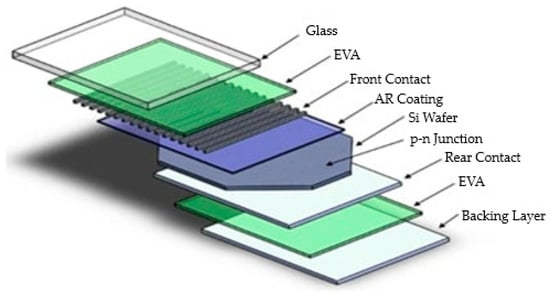
Figure 1.
PV panel layers.
2.2. Recycling of Solar Panels
Solar panel recycling is the process of separating panels into their components to reduce the potential environmental impacts of decommissioned, damaged, or unusable PV panels. The materials recovered through this separation process can be reused as raw materials in new solar energy systems. As a result, a sustainable and circular economy can be promoted while reducing the environmental footprint.
However, it is extremely important that solar panels are subjected to a specialized recycling process in order to minimize material loss during recovery. Most of the materials found in solar panel modules consist of glass, aluminum, and plastics. End-of-life solar modules are processed in recycling facilities and separated into their components using appropriate methods, as shown in Figure 2. While the majority of these components are aluminum frames and glass, a recycling efficiency of over 90% by weight can be achieved.

Figure 2.
Solar panel recycling process.
According to the data of the International Energy Agency Photovoltaic Power Systems Program (IEA PVPS) and the International Renewable Energy Agency (IRENA), the amount of waste PV modules worldwide was 250,000 tons in 2016, while it is projected to reach 1.7 to 8.0 million tons by 2030 and 60 to 78 million tons by 2050 [2]. These data reveal that panel recycling is extremely important both economically and environmentally.
The recycling strategy for solar panels is based on the stages of separating the layers from one another (delamination) as well as the separation and purification of different elements that are found in limited quantities in nature [3]. When the literature is examined, it is seen that physical, chemical, and thermal recycling methods are widely used [4].
Physical recycling involves physically breaking down the panels to separate materials such as glass, metal, and plastic. In this process, aluminum frames, junction boxes, and cables are removed and recycled. The panels are then crushed or fragmented for the next stage.
Thermal recycling applies high temperatures (450–650 °C) to vaporize certain components and recover others [5]. At this stage, 90–95% of the glass can be recovered.
Chemical recycling uses different solvents and solutions such as phosphoric acid, toluene, sulfuric acid, sodium sulfide, and trichloroethylene to recover valuable elements from solar panels [6,12,13]. As a result of this process, cadmium (Cd) and tellurium (Te)—which are found in small quantities in nature—can be reintegrated into the production process.
2.3. Solar Energy Potential and PV Recycling in Türkiye
2.3.1. Türkiye’s Solar Energy Potential
In addition to the increase in the world population, the demand for energy is constantly rising due to technological development, industrialization, and urbanization. Owing to limited energy resources and global developments, countries are trying to develop new measures and policies to meet their energy needs.
Electrical energy has become one of the most important elements of daily life. With technological advancements, the number of electrical devices has increased significantly, and electricity is now used in every sector, from industry to lighting. Electrical energy also supports economic growth by increasing the efficiency of capital, labor, and other production factors. It contributes to improved welfare by boosting industrial and infrastructure investments as well as exports [22].
In Figure 3, Türkiye’s installed power capacity is presented by year. When the figure is examined, it is clearly seen that there has been a steady increase in installed power capacity. While the country’s installed power was 27,264 MW in the early 2000s, TEİAŞ data show that this figure has increased nearly fourfold, reaching 110,914 MW in 2023 [23].
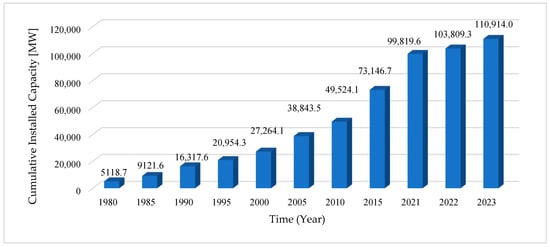
Figure 3.
Development of Türkiye’s installed power by year.
Due to the ever-increasing demand for energy, countries are developing alternative solutions to meet their energy needs. The main focus of these efforts is on renewable energy sources, such as wind, solar, and geothermal energy. Interest in renewable energy sources is growing significantly both worldwide and in our country. When Figure 4 is examined, it is seen that the share of renewable energy sources in installed power was around 9% in 2013, while this rate increased to 42% in 2023 [23].
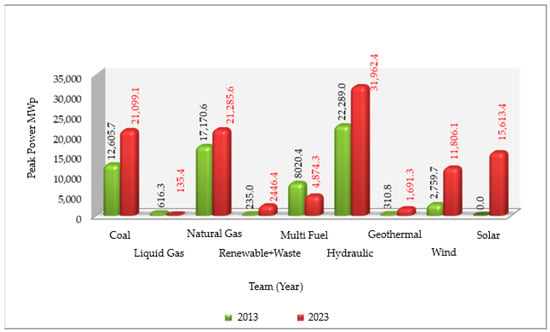
Figure 4.
Türkiye’s installed power by primary energy source between 2013 and 2023.
Undoubtedly, the renewable energy sources with the largest share are wind and solar energy. Türkiye has significant potential in solar energy compared to many countries around the world. Electricity generation capacity from solar energy has shown a remarkable increase in recent years [24].
According to the TEİAŞ Installed Power Report of December 2022, there were 9353 solar power plants in Türkiye. Of these, 38 were licensed and 9315 were unlicensed. The total energy production capacity of these power plants was 9425.4 MW [23].
According to TEİAŞ data, as of January 2025, there are 31,642 solar power plants in Türkiye, and their total production capacity is 20,016.3 MW. When the data from 2022 and 2025 are compared, it is clearly seen that electricity generation capacity from solar energy has increased by 112.37% [25].
When Figure 5 is examined, it can be seen that the installed power capacity of photovoltaic systems—where light is directly converted into electricity—has been continuously increasing in Türkiye.
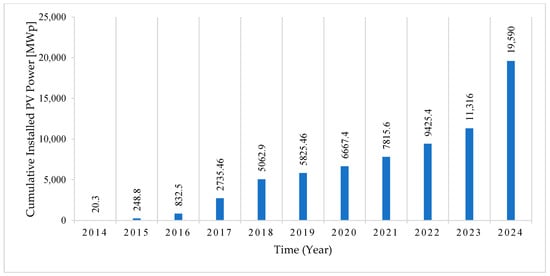
Figure 5.
Türkiye’s annual installed solar energy power between 2014 and 2024.
The first solar power plant for electricity generation in Türkiye was established in İstanbul İkitelli in 2011, with an installed power capacity of 500 kW, in cooperation with TÜBİTAK and İnosol Enerji. Since 2018, both the number of newly established plants and the installed power capacity have shown a continuous upward trend. Considering that the average lifespan of photovoltaic modules is 25 years, this situation may lead to serious environmental problems in the near future due to the materials used in panels having either reached the end of their life or become unusable for various reasons. Additionally, the fact that panels contain elements that are limited in nature and that photovoltaic modules are almost 99% recyclable presents certain economic opportunities.
2.3.2. PV Recycling in Türkiye
Investments in the renewable energy sector have also significantly increased in Türkiye in recent years. While the total installed power of PV systems in Türkiye was 5062.9 MW in 2018, this figure reached 20,016.3 MW as of January 2025. According to data from the Ministry of Energy and Natural Resources (ETKB), Türkiye’s total electricity installed capacity from renewable energy sources is expected to reach 189.7 GW by 2035. Similarly, the installed solar energy capacity is estimated to reach 52.9 GW [26]. This clearly indicates that Türkiye will face the issue of PV module waste in the near future.
According to data published by the International Energy Agency (IEA) and the International Renewable Energy Agency (IRENA), the global amount of PV module waste is expected to reach 68–70 million tons, and Türkiye’s share is estimated at 600,000 tons by 2050 [27].
In recent years, Türkiye has made significant efforts regarding waste management. The Zero Waste Regulation was issued on 12 July 2019, and the Regulation on the Management of Waste Electrical and Electronic Equipment was enacted on 26 December 2022. However, there is currently no specific legal regulation for determining the recycling and recovery methods or targets for PV modules.
2.4. Methods
The rapid development and cost reduction in the solar energy sector indicate that PV systems will play a key role in the transition to sustainable energy sources. In this study, a projection was made regarding the changes in Türkiye’s PV system installed capacity and PV waste amounts up to the year 2050, evaluated at specific intervals.
Two forecasting methods—a multiple regression model and artificial neural networks (ANNs)—were used to estimate Türkiye’s PV installed capacity. Based on the resulting data, the amount of recyclable PV module waste was calculated. For both methods, TEİAŞ data from 2014 to January 2025 were used, and the obtained data are presented.
2.4.1. Description of the Designed Artificial Neural Network Model
In this study, an artificial neural network model—one of the statistical demand forecasting techniques—was used to predict the PV system installed capacity in Türkiye over a specified time range. The ANN model is a feed-forward backpropagation neural network, which was selected due to its high prediction performance in both linear and nonlinear models. The designed model consists of 4 input nodes, a single hidden layer with 5 neurons, and 1 output layer. In addition, a single-period iterative method was employed for estimation using the ANN.
The dependent variable in the model shown in Figure 6 is the annual installed power of PV system modules. The independent variables are monthly and annual production data, calendar dates, and monthly production variations caused by seasonal effects. In this study, 24 randomly selected rows (16.66%) from 4 series and 144 data points were used as the test set, and 120 randomly selected rows (83.34%) were used as the training set. In other words, approximately 83.34% of the dataset was reserved for training and 16.66% for testing. The online backpropagation algorithm was used to train the network, with the initial learning rate and momentum values set to 0.1.
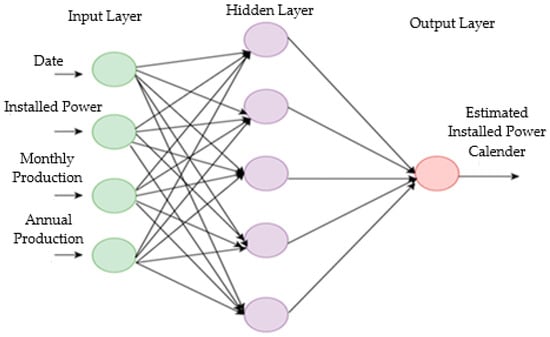
Figure 6.
Architecture of designed artificial neural network model.
2.4.2. Prediction Model with Multiple Regression
Regression analysis, one of the combined forecasting methods, is used to predict the future status of a variable (dependent or independent). It can also be used to model the mathematical relationships between one or more variables. In this study, a secondary estimation model was created using the multiple linear regression method. Equation (1) was used to perform the multiple regression calculation.
In Equation (1), , , and are the independent input variables; Y is the output dependent variable; and , , and are the regression coefficients. In this study, represents the PV module installed power as the first independent input variable, while corresponds to the year as the second independent input variable. The dependent output variable , which is intended to be estimated through regression, refers to the predicted amount of PV installed power. The equations defined below were used to calculate the coefficients.
2.4.3. PV Module Recycling Life Cycle Analysis and Waste Quantity Calculation
Life Cycle Analysis (LCA) is used to identify, report, and manage the environmental impacts of various stages throughout the life cycle of a product or service. This begins with the acquisition of raw materials used in production and covers all related processes, such as manufacturing, transportation, consumer use, and final disposal or recycling of waste after use [28].
Interest in LCA studies has significantly increased in recent years, especially to enhance efficiency based on principles of sustainability and circularity. The stages of LCA are shown in Figure 7.
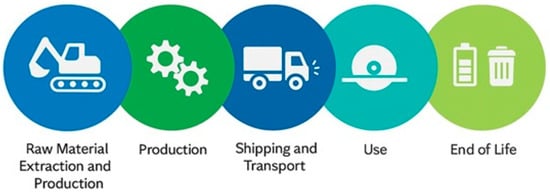
Figure 7.
Life cycle analysis.
Due to the increasing global demand for energy, the widespread adoption of solar panels has brought the concept of recycling into focus. It is evident that the recycling of solar panels is extremely important in terms of both environmental and economic sustainability and circularity. When the reports published by IEA and IRENA are examined, the following data are noted:
- Damage during transportation and installation: 0.05%;
- Malfunctions within the first two years due to installation errors: 0.05%;
- Malfunctions due to various causes after 10 years of installation: 2%;
- Technical failures due to various reasons after 15 years of installation: 4%.
It has also been stated that the loss rate in panels due to climatic changes is 0.0012% [27,29].
In the report published by IRENA in 2016, data on the quantity of waste panels between 2016 and 2050 under two different scenarios were analyzed using the Weibull probability distribution function in Equation (7).
where
- is the shape (form) factor;
- is the average lifespan of the panels;
- is the year for which the calculation is made.
In this published report, where the average lifespan of panels is assumed to be 30 years, the shape factor for regular loss in the first scenario is taken as 5.3759, and it is estimated that the total amount of waste panels in the world will reach 60 million tons by 2050. In the second scenario, the shape factor for early losses is taken as 2.4928, and the estimated waste panel amount reaches 78 million tons by 2050 [27].
The amount of waste panels that will have reached end of life in Türkiye is estimated as follows:
- 200,000 tons by 2050 under the regular loss scenario;
- 400,000 tons under the early loss scenario.
In [30], the failures and lifetimes of PV panels were investigated using the Weibull distribution. A study was conducted on censored datasets obtained from some photovoltaic power plants. In this study, Weibull analysis was used to determine the probability density distribution of the failure of PV panels. From the data collected over a period of 12 years, it was stated that agricultural PV systems fail due to exposure to extreme effects of agriculture such as dust, humidity, vibration, fertilizers, etc., and their lifespan is shorter than the data declared by the manufacturers [30].
In this study, a preliminary analysis was carried out to estimate Türkiye’s waste panel capacity and quantity potential for the period 2025–2050, based on installed power data from 2014 to 2025.
In the case that solar panels become unusable due to various reasons, the power loss is calculated using Equation (8), defined as follows:
= Solar panel power loss at the end of its life, ;
= Solar panel power loss due to climatic conditions and unforeseen reasons, ;
= Solar panel power loss due to failures occurring during the year, .
The total amount of solar panel waste is then calculated using Equation (9), as follows:
where represents the total number of unusable solar panels and represents the weight of a solar panel. The total number of unusable solar panels is expressed as
where is the installed power (Watt) of a single solar panel.
3. Results and Discussion
Short-term or long-term projection studies can be conducted for future periods using data obtained from past periods through estimation methods. Therefore, it can be stated that accurately and reliably predicting uncertain future conditions is extremely important for the effectiveness of such studies.
In this study, the annual installed power data published by TEİAŞ between 2014 and 2024 were used to estimate the installed capacity up to 2050. Based on the analysis results, the waste potential of photovoltaic solar modules was calculated.
The calculation metrics used in the simulation analyses are as follows:
The estimated annual increase in Türkiye’s installed photovoltaic power was calculated using multiple regression analysis and artificial neural networks (ANNs), and the results are presented in Figure 8.

Figure 8.
Installed solar energy power estimate for Türkiye.
Türkiye’s installed solar power capacity is on a continuous upward trend. However, PV panels that become unusable due to transportation, installation issues, climatic stress, and various failures throughout the year result in power loss. In calculating this power loss, the equations defined in the previous section were used, and the total waste panel power loss was determined.
While the increase in waste panel power loss—dependent on the growth of total installed photovoltaic panel capacity between 2014 and 2038—follows a horizontal trend, the end-of-life phase of PV panels, starting from 2039 due to a decline in efficiency, is accelerated, as shown in Figure 9.
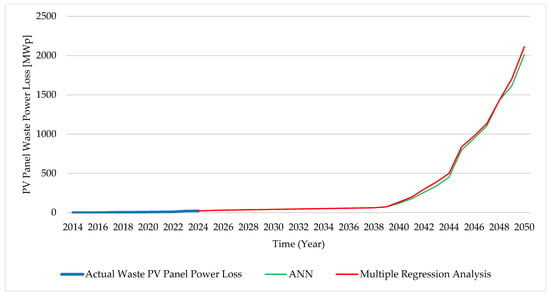
Figure 9.
Estimated power loss from waste PV panels in Türkiye based on solar energy board data.
When the figure is examined, it is estimated that Türkiye’s installed photovoltaic power will reach approximately 60,680 MW by 2050, based on the analysis using the ANN model. Similarly, according to the multiple regression analysis, it is estimated to be 70,552 MW. It is clearly seen that the obtained data are highly consistent with the 2016 IEA and IRENA reports. Numerical data related to Figure 9 are presented in detail in Table 1.

Table 1.
Estimated power loss from end-of-life waste PV panels in Türkiye.
Table 1 shows the total power loss resulting from end-of-life waste panels for the ANN and multiple regression analyses. When Table 1 is examined, the total power loss in 2024 is found to be 83.77 MW. According to the ANN model analysis, the total installed power loss in 2050 is estimated to be 10,053.02 MW, while the multiple regression analysis yields a value of 10,527.97 MW.
Total waste volume was calculated using the estimated power loss data of end-of-life waste PV panels in Türkiye with the help of Equation (9). Data from IEA and IRENA [28] as well as ANN and multiple regression analyses are presented in Figure 10. It is clearly seen that the estimates obtained using the ANN model are highly consistent with the projections made by IEA and IRENA.
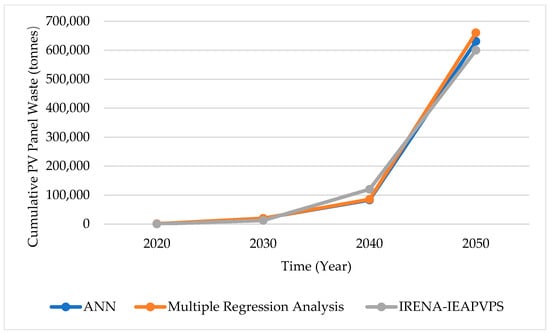
Figure 10.
Estimated cumulative waste volumes (tonnes) of end-of-life PV panels in Türkiye.
Numerical data related to Figure 10 are presented in detail in Table 2. When Table 2 is examined, the total waste amount in 2020 is 1377 tonnes. According to the ANN model analysis, the total PV panel waste amount in 2050 is estimated to be 630,778 tonnes, while the multiple regression analysis yields a value of 660,579 tonnes. According to the IEA and IRENA estimates, the projected waste panel amount in Türkiye for 2050 is 600,000 tonnes [27].

Table 2.
Estimated total amount of waste of end-of-life PV panels in Türkiye.
In this study, the Mean Absolute Percentage Error (MAPE) and coefficient of determination () were used to compare Artificial Neural Network (ANN) and multiple regression analysis methods to evaluate the convergence between the actual and predicted values. The performance metrics of the ANN and multiple regression models for both the training and test datasets are presented in Table 3.

Table 3.
Estimated error and reliability results.
According to the test dataset results, the MAPE value of the ANN model was found to be 0.08423, whereas the corresponding value for the multiple regression model was 1.05741.
Similarly, the value obtained with the ANN was 0.98664, and the value obtained with multiple regression analysis was 0.97124. These results indicate that the proposed ANN model provides more accurate estimates of both the installed power and the projected waste quantity when compared to the multiple regression analysis. As a result, sudden changes and deviations in the data set negatively affect multiple regression analysis but do not greatly affect artificial neural networks.
4. Conclusions
Interest in solar energy is increasing day by day. Countries’ investments in solar energy systems continue to grow due to reasons such as competitiveness, reduced foreign dependency, environmental friendliness, and the fact that it is derived from natural resources. With the growing prevalence of photovoltaic (PV) technology, the environmentally responsible disposal of panels that have reached the end of their service life—i.e., waste panels—has become a significant topic of discussion in recent years.
In this study, a new Artificial Neural Network (ANN) model was developed to estimate Türkiye’s PV panel waste quantity up to 2050. The suitability of the developed model was compared with the results of multiple regression analysis and with the estimates of the IEA and IRENA. It was observed that the proposed model demonstrated a high level of consistency and accuracy compared to other models and estimates.
The findings of the study indicate that PV module waste will become a serious issue after the 2030s. The recycling process of PV panels needs to be addressed from three dimensions.
Firstly, countries need to establish legal regulations for the recycling of PV modules and clearly define the waste management process. Comprehensive efforts should be made to ensure that all processes—collection, storage, and disposal—are carried out in a manner that minimizes environmental impact.
Secondly, the recycling of solar panels is of great importance in terms of sustainability. After panels reach the end of their lifespan, valuable materials (e.g., silver, silicon, aluminum) can be recovered and reused as raw materials in production.
Finally, while solar panels play a critical role in reducing carbon emissions and decreasing dependence on fossil fuels, the environmental footprint of this technology must be thoroughly evaluated and optimized. Reducing environmental impacts at every stage—from production to end of life and recycling—can provide a truly sustainable solution while also offering economic benefits.
In conclusion, this study may serve as a guide for sustainable energy practices, particularly in the areas of solar panel recycling and performance analysis.
Funding
This research received no external funding.
Informed Consent Statement
Not applicable.
Data Availability Statement
The data are available from the author upon request.
Conflicts of Interest
The author declares no conflicts of interest.
Abbreviations
The following abbreviations are used in this manuscript:
| ANN | Artificial Neural Network |
| ETKB | Ministry of Energy and Natural Resources |
| EVA | Ethylene Vinyl Acetate |
| IEA | International Energy Agency |
| IRENA | International Renewable Energy Agency |
| IEA PVPS | International Energy Agency Photovoltaic Power Systems Program |
| GW | Giga Watt |
| LCA | Life cycle analysis |
| MSE | Mean Square Error |
| MAPE | Mean Absolute Percentage Error |
| MW | Mega Watt |
| PV | Photovoltaic |
| t | Ton |
| TEİAŞ | Turkish Electricity Transmission Corporation |
| WEEE | Waste Electrical and Electronic Equipment |
References
- Ritchie, H.; Rosado, P. Energy Mix. 2024. Available online: https://ourworldindata.org/energy-mix#:~:text=Globally%20we%20get%20the%20 largest,sources%20are%20now%20growing%20quickly (accessed on 10 October 2024).
- Bakhiyi, B.; Labrèche, F.; Zayed, J. The photovoltaic industry on the path to a sustainable future—Environmental and occupational health issues. Environ. Int. 2014, 73, 224–234. [Google Scholar] [CrossRef] [PubMed]
- Chi, X.; Wang, M.Y.; Reuter, M.A. E-waste collection channels and household recycling behaviors in Taizhou of China. J. Clean. Prod. 2014, 80, 87–95. [Google Scholar] [CrossRef]
- Graham, E.; Fulghum, N. Solar Power Continues to Surge in 2024. Available online: https://ember-energy.org/app/uploads/2024/11/Report-Solars-record-breaking-growth-in-2024.pdf (accessed on 10 October 2024).
- Liu, L.Q.; Wang, Z.X.; Zhang, H.Q.; Xue, Y.C. Solar energy development in China—A review. Renew. Sustain. Energy Rev. 2010, 14, 301–311. [Google Scholar] [CrossRef]
- Xu, Y.; Li, Y.; Tan, Q.; Peters, A.L.; Yang, C. Global status of recycling waste solar panels: A review. Waste Manag. 2018, 75, 450–458. [Google Scholar] [CrossRef] [PubMed]
- Aman, M.M.; Solangi, K.H.; Hossain, M.S.; Badarudin, A.; Jasmon, G.B.; Mokhlis, H.; Bakar, A.H.A.; Kazi, S.N. A review of Safety, Health and Environmental (SHE) issues of solar energy system. Renew. Sustain. Energy Rev. 2015, 41, 1190–1204. [Google Scholar] [CrossRef]
- Choi, J.K.; Fthenakis, V. Design and optimization of photovoltaics recycling infrastructure. Environ. Sci. Technol. 2010, 44, 8678–8683. [Google Scholar] [CrossRef] [PubMed]
- Galan, J.E.; Lopez, L.; Wambach, K.; Rover, I. Recovering of waste monocrystal silicon solar panels in order to be used in PV modules manufacturing. In Proceedings of the 20th European Photovoltaic Solar Energy Conference, Barcelona, Spain, 6–10 June 2005. [Google Scholar]
- Cucchiella, F.; D’Adamo, I.; Koh, S.L.; Rosa, P. Recycling of WEEEs: An economic assessment of present and future e-waste streams. Renew. Sustain. Energy Rev. 2015, 51, 263–272. [Google Scholar] [CrossRef]
- Bio Intelligence Service. Study on Photovoltaic Panels Supplementing the Impact Assessment for a Recast of WEEE Directive. Report for the European Commission DG ENV (Project No. ENV.G.4/FRA/2007/0067). 2011. Available online: https://ec.europa.eu/environment/pdf/waste/weee/Study%20on%20PVs%20Bio%20final.pdf (accessed on 20 January 2025).
- McDonald, N.C.; Pearce, J.M. Producer responsibility and recycling solar photovoltaic modules. Energy Policy 2010, 38, 7041–7047. [Google Scholar] [CrossRef]
- Czanderna, A.W.; Pern, F.J. Encapsulation of PV modules using ethylene vinyl acetate copolymer as a pottant: A critical review. Sol. Energy Mater. Sol. Cells 1996, 43, 101–181. [Google Scholar] [CrossRef]
- Yamashita, K.; Umemoto, A.; Okamoto, K. Research and development on recycling and reuse treatment technologies for crystalline silicon photovoltaic modules. In Proceedings of the Third World Congress on PV Energy, Osaka, Japan, 11–18 May 2003. [Google Scholar]
- Wambach, K. Recycling of solar panels and photovoltaic modules. In Proceedings of the 19th European Photovoltaic Solar Energy Conference, Paris, France, 7–11 June 2004; pp. 2018–2023. [Google Scholar]
- Zakharchenko, R.; Licea-Jimenez, L.; Pérez-Garcıa, S.A.; Vorobiev, P.; Dehesa-Carrasco, U.; Perez-Robles, J.F.; Gonzalez-Hernandez, J.; Vorobiev, Y. Photovoltaic solar panel for a hybrid PV/thermal system. Sol. Energy Mater. Sol. Cells 2004, 82, 253–261. [Google Scholar] [CrossRef]
- Rüstemli, S.; Dinçer, F.; Çelik, M.; Cengiz, M.S. Fotovoltaik Paneller: Güneş Takip Sistemleri ve İklimlendirme Sistemleri. Bitlis Eren Üniversitesi Bilim. Derg. 2013, 2, 141–147. [Google Scholar]
- Karpuz, G. Güneş Paneli Üretiminde Kullanılan Yarı İletken Malzemeler. Metalurji Ve Malzeme Mühendisleri Odası Dergisi. 2020. Available online: https://metalurji.org.tr/ehaber/2020_07/18_Makale_Gunes_Paneli.pdf (accessed on 10 February 2025).
- Yeşerenerji. Şeffaf Güneş Pilleri. 7 July 2021. Available online: https://yeserenerji.com/seffaf-gunes-pilleri/ (accessed on 11 February 2025).
- Anonim. 2011. Available online: www.gunessistemleri.com (accessed on 11 February 2025).
- Smith, Y.R.; Bogust, P. Review of solar silicon recycling. In Tms Annual Meeting & Exhibition; Springer International Publishing: Cham, Switzerland, 2018; pp. 463–470. [Google Scholar]
- Yapraklı, S.; Yurttançıkmaz, Ç. Elektrik Tüketimi ile Ekonomik Büyüme Arasındaki Nedensellik: Türkiye Üzerine Ekonometrik Bir Analiz. C.Ü. İktisadi İdari Bilim. Dergisi 2012, 13, 195–215. [Google Scholar]
- TEİAŞ. Türkiye Elektrik İletim A.Ş. Yük Tevzi Dairesi Başkanlığı Kurulu Güç Raporu. Ankara: Türkiye Elektrik İletim A.Ş. Yük Tevzi Dairesi Başkanlığı. 2022. Available online: https://webim.teias.gov.tr/file/a5ec8c53-fad2-4b3d-b056-db93a70a0fa3?download (accessed on 24 January 2025).
- Canka Kılıç, F. Güneş Enerjisi, Türkiye’deki Son Durumu Ve Üretim Teknolojileri. Eng. Mach. Mag./Mühendis Makina 2015, 56, 28–40. [Google Scholar]
- TEİAŞ. 2025. Available online: https://ytbsbilgi.teias.gov.tr/ytbsbilgi/frm_istatistikler.jsf (accessed on 13 February 2025).
- T.C. Enerji ve Tabii Kaynaklar Bakanlığı, Information Center. Available online: https://enerji.gov.tr/bilgi-merkezi-enerji (accessed on 13 February 2025).
- Weckend, S.; Wade, A.; Heath, G.A. End of Life Management: Solar Photovoltaic Panels; No. NREL/TP-6A20-73852; T12-06: 2016; National Renewable Energy Laboratory (NREL): Golden, CO, USA, 2016. Available online: https://www.osti.gov/servlets/purl/1561525 (accessed on 12 November 2024).
- Demirer, G. Life Cycle Analysis (LCA) and Application Examples Capacity Building in the Field of Environment Project Integrated Product Policies and Sustainable Resource Management Regional Environmental Center; REC Türkiye, REW: Istanbul, Türkiye, 2011; 40p. [Google Scholar]
- Abdurakhmanov, B.; Ochildiev, O. Estimation of possible volumes of solar panel waste generation in the Republic of Uzbekistan. E3S Web Conf. 2024, 563, 01017. [Google Scholar] [CrossRef]
- Poulek, V.; Ales, Z.; Finsterle, T.; Libra, M.; Beránek, V.; Severová, L.; Belza, R.; Mrázek, J.; Kozelka, M.; Svoboda, R. Reliability characteristics of first-tier photovoltaic panels for agrivoltaic systems–practical consequences. Int. Agrophysics 2024, 38, 383–391. [Google Scholar] [CrossRef] [PubMed]
Disclaimer/Publisher’s Note: The statements, opinions and data contained in all publications are solely those of the individual author(s) and contributor(s) and not of MDPI and/or the editor(s). MDPI and/or the editor(s) disclaim responsibility for any injury to people or property resulting from any ideas, methods, instructions or products referred to in the content. |
© 2025 by the author. Licensee MDPI, Basel, Switzerland. This article is an open access article distributed under the terms and conditions of the Creative Commons Attribution (CC BY) license (https://creativecommons.org/licenses/by/4.0/).